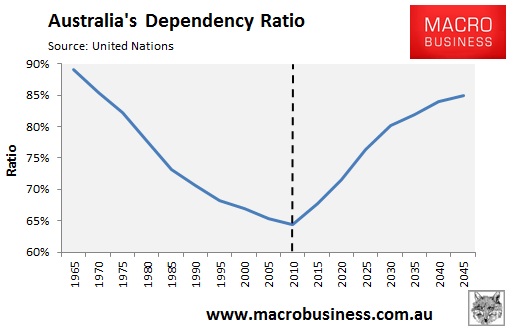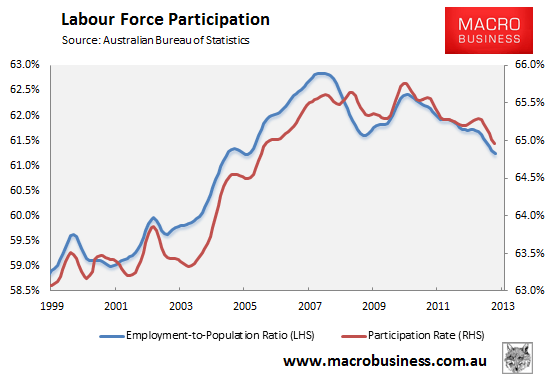
The Weekend AFR contained an interesting article contending that Australia’s baby boomer generation are finally starting to exit the workforce en masse after many delayed retirement in the wake of the Global Financial Crisis (GFC):
The long-awaited surge in retirements by baby boomers is gathering pace, driven by a rebound in share prices and the property market…
[AMP’s Shane] Oliver said while the natural pattern of retirements was disrupted between 2008 and 2010, more Australians are now retiring because of rising asset prices, including a 20 per cent rise in stocks over the past year…
James Kenny, a senior advisor at Brisbane-based Tupicoffs, which specialises in advising high-net-worth clients, said he expects a surge in retirements in coming years…
Speculation about rising boomer retirements intensified this week when the Bureau of Statistics reported the proportion of people in work or actively searching for jobs fell in September to a seven-year low of 64.9 per cent…
Research by the Australian Council of Trade Unions, based on ABS data, shows almost all of the drop in participation since late 2010 is due to the aging population.
Tim Lyons, assistant ACTU secretary, said the fall “is largely demographic, not economic.”
“It’s not surprising that the participation rate would start to fall once the baby-boomer generation started turning 65, and that is what has happened in the past few years,” he said…
I have long argued that the coming retirement of the large baby boomer population would cause stiff headwinds for the Australian economy, as well as many other advanced economies around the world.
According to United Nations (UN) population data, Australia’s dependency ratio – i.e. the ratio of the non-working population, both children (< 20 years old) and the elderly (> 65 years old), to the working aged population – fell steadily in the decades to 2010. However, in the decades ahead, the dependency ratio is projected to rise steadily as the baby boomers retire and the population ages (see next chart).

Accordingly, measures of labour force participation – i.e. both the official participation rate and the employment-to-population ratio – have begun to trend lower, and will likely continue to do so over the decades ahead (see next chart).

The impact on the Australian economy from an ageing population are multi-faceted.
First, the potential growth rate of the economy will be lower due to the falling worker share. This will mean that it will become more difficult to grow incomes and raise living standards, other things equal.
Second, the Government will come under increasing financial pressure, due to the shrinking tax base. The problem will also be exacerbated by the higher proportion of the population demanding aged health care and/or the state pension. Accordingly, either taxes will need to rise to cover the increasing costs, or entitlements will need to be drastically cut.
Finally, asset prices are likely to come under increasing pressure due to: 1) a lower proportion of workers (savers) channeling funds into investments; and 2) a higher proportion of retirees drawing down on their savings/assets.
As argued many times previously, the high growth rates experienced in the decades leading-up to the GFC were an anomaly and growth is likely to be far more sedate going forward as the population ages and dependency ratios worsen, in addition to the unwinding of the joint credit and mining booms.

